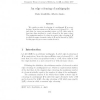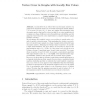16 search results - page 2 / 4 » The incidence game chromatic number |
JGT
2008
13 years 4 months ago
2008
: This article proves the following result: Let G and G be graphs of orders n and n , respectively. Let G be obtained from G by adding to each vertex a set of n degree 1 neighbors....
JGT
2007
13 years 4 months ago
2007
A cyclic colouring of a plane graph is a vertex colouring such that vertices incident with the same face have distinct colours. The minimum number of colours in a cyclic colouring...
CSJM
2007
13 years 4 months ago
2007
We consider a strict k-colouring of a multigraph G as a surjection f from the vertex set of G into a set of colours {1,2,. . . ,k} such that, for every non-pendant vertex x of G, ...
DM
2008
13 years 5 months ago
2008
We construct an "orbital Tutte polynomial" associated with a dual pair M and M of matrices over a principal ideal domain R and a group G of automorphisms of the row spac...
ICALP
2011
Springer
12 years 8 months ago
2011
Springer
In [13], Erd˝os et al. defined the local chromatic number of a graph as the minimum number of colors that must appear within distance 1 of a vertex. For any ∆ ≥ 2, there are ...


